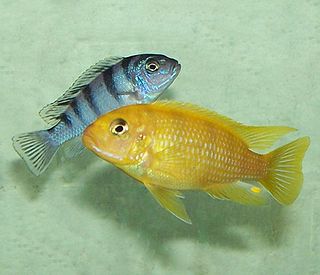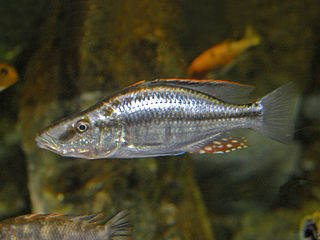
Lake Malawi, also known as Lake Nyasa in Tanzania and Lago Niassa in Mozambique, is an African Great Lake and the southernmost lake in the East African Rift system, located between Malawi, Mozambique and Tanzania.

Labidochromis caeruleus is a species of cichlid endemic to the central western coastal region of Lake Malawi in East Africa. It is also known as lemon yellow lab, the blue streak hap, the electric yellow or yellow prince, depending on the colour morph. A naturally occurring yellow-coloured variant from Lion's Cove is one of the most popular cichlids amongst aquarium hobbyists.

Mbuna is the common name for a large group of African cichlids from Lake Malawi, and are members of the haplochromine family. The name mbuna means "rockfish" in the language of the Tonga people of Malawi. As the name implies, most mbuna are cichlids that live among the piles of rocks and along the rocky shores of Lake Malawi, as opposed to the utaka, cichlids that live in the open water or on sandy shores or soft substrates. Some species of mbuna are highly sexually dimorphic, although many are not. Almost all of the cichlid species of Lake Malawi, including mbuna and non mbuna such as the utaka, are believed to have descended from one or a very few species that became isolated in the lake. With rising water levels, new habitats could be colonized and the many isolated rocky outcrops allowed new mbuna species to form. Their striking colors, intriguing behavioral characteristics, and relative hardiness make them very popular despite their unique demands for the home aquarist.

Maylandia estherae is a haplochromine cichlid. It is a rock dwelling fish or mbuna from Lake Malawi. This fish, like most cichlids from Lake Malawi, is a mouthbrooder - females hold their fertilized eggs then fry in their mouths until they are released after about 21 days.

Pseudotropheus is a genus of fishes in the family Cichlidae. These mbuna cichlids are endemic to Lake Malawi in Eastern Africa.

The terms shell dwellers or shelldwellers, shell-breeding, or ostracophil are descriptive terms for cichlid fish that use the empty shells of aquatic snails as sites for breeding and shelter. The terms have no taxonomic basis, although most shell-dwelling cichlids are from Lake Tanganyikas lamprologine lineage. Many shell dwelling cichlids are popular with fishkeepings and are frequently kept in aquaria.

Maylandia or Metriaclima is a genus of haplochromine cichlids endemic to Lake Malawi in East Africa. They belong to the mbuna (rock-dwelling) haplochromines.

Maylandia lombardoi, is a 13 centimetres (5.1 in) long freshwater fish from the family Cichlidae. This species is popular in the aquarium hobby where it is sold under a variety of common names including: lombardoi mbuna, kenyi mbuna or kennyi mbuna or kenyi cichlid. This species is sometimes seen in the genus Metriaclima owing to a dispute in which a minority of cichlid researchers do not consider Maylandia valid (see Maylandia for discussion. The specific name honours the exotic fish dealer John Lombardo.

The kampango or kampoyo is a critically endangered species of large and predatory bagrid catfish that is endemic to Lake Malawi, Lake Malombe and the upper Shire River in Africa. It prefers areas near rocks in water shallower than 50 m (160 ft), but it also occurs deeper and over a sandy or muddy bottom.

The haplochromine cichlids are a tribe of cichlids in subfamily Pseudocrenilabrinae called Haplochromini. This group includes the type genus (Haplochromis) plus a number of closely related genera such as Aulonocara, Astatotilapia, and Chilotilapia. They are endemic to eastern, southern and northern Africa, except for Astatotilapia flaviijosephi in the Middle East. A common name in a scientific context is East African cichlids – while they are not restricted to that region, they are the dominant Cichlidae there. This tribe was extensively studied by Ethelwynn Trewavas, who made major reviews in 1935 and 1989, at the beginning and at the end of her career in ichthyology. Even today, numerous new species are being described each year.

Melanochromis auratus, the auratus cichlid, is a freshwater fish of the cichlid family. It is also known as golden mbuna and Malawi golden cichlid. It is endemic to the southern region of Lake Malawi, particularly from Jalo Reef southward along the entire western coast down to Crocodile Rocks.

Iodotropheus sprengerae, the rusty cichlid, lavender mbuna or lavender cichlid, is a species of cichlid endemic to the Boadzulu and Chinyankwazi Islands and Chinyamwezi Island regions of Lake Malawi. It prefers a temperature range of 24-26 °C.

Pseudotropheus johannii or the bluegray mbuna is an African freshwater fish from the family Cichlidae.
Copadichromis geertsi is a species of haplochromine cichlid which is endemic to Lake Malawi.

The Malawi eyebiter is a species of fish in the family Cichlidae. This predatory cichlid is endemic to Lake Malawi in East Africa.

The zebra mbuna is a species of cichlid endemic to Lake Malawi in Africa. This species can reach a length of 11.3 cm (4.4 in). It feeds on aufwuchs, a surface layer of mostly algal material that grows on rocks. This cichlid is a mouthbrooder and the female broods the eggs in her mouth for about three weeks. This fish can sometimes be found in the aquarium trade.

Pseudotropheus cyaneorhabdos is a species of cichlid endemic to Lake Malawi where it is only known from around Likoma Island where it prefers rocky substrates at depths of from 5 to 10 metres. This species can grow to a length of 7.5 centimetres (3.0 in) SL. Also known as Maingano, this mbuna is often confused with P. johannii. One important distinguishing characteristic is that females are not orange, whereas female P. johanii are. Both male & female P. cyaneorhabdos are colored the same; however, males may have more intense coloring, particularly in dominant or sexually active males. Another key distinguishing feature of P. cyaneorhabdos from P. johannii is the lack of vertical stripes. The horizontal stripes of P. cyaneorhabdos have been used to study the genetic control of phenotypic traits like coloration.

Pseudotropheus demasoni is a species of cichlid endemic to Lake Malawi where it is only known from the Pombo Rocks in Tanzanian waters. This species can potentially reach a maximum length of 10 centimetres (3.9 in) SL. It is now commonly found in the aquarium trade.

Pseudotropheus saulosi is a species of cichlid endemic to Lake Malawi in East Africa, where it lives in areas with rocky substrates. It is classified as a dwarf-mbuna and was first described by Ad Konings in 1990, who gave it the specific name saulosi in honour of Saulos Mwale who caught over 3,000 specimens in a single day on the expedition which collected the type. It comes from an area of the lake called Taiwan Reef, and from nowhere else. This fish can also be found in the aquarium trade.

Pseudotropheus sp. "acei" is a Mbuna cichlid from Lake Malawi that grows to around 6 in (15 cm) in length. Although known for many years, it has not been formally described. There are two different varieties: The most common yellow-tailed Pseudotropheus sp. "acei" (Msuli), and the white-tailed Pseudotropheus sp. "acei" (Ngara). Like most Mbuna, it dwells in shallower waters, however it will sometimes go near the surface, which is very uncommon for Mbunas. It is a very common fish for fish-keepers. It gets its common name from its blue body and yellow tail. Originally discovered in 1922 by Regan, the acei was originally believed to be a Pseudotropheus, but was later changed to Gephyrochromis and then back again. It prefers the sandy and rock filled shoreline where sunken logs are easily accessed. This species has developed the advantage of being able to harvest algae from submerged logs and roots. They are equipped with typical Gephyrochromid cuspid-like teeth that are flat for removing epixlyic or epilithic algae from wood. In the lake, schools of 30-50 individuals surrounding a large log are not uncommon, however in the rocky areas; schools usually consist of 3-10 individuals.



















